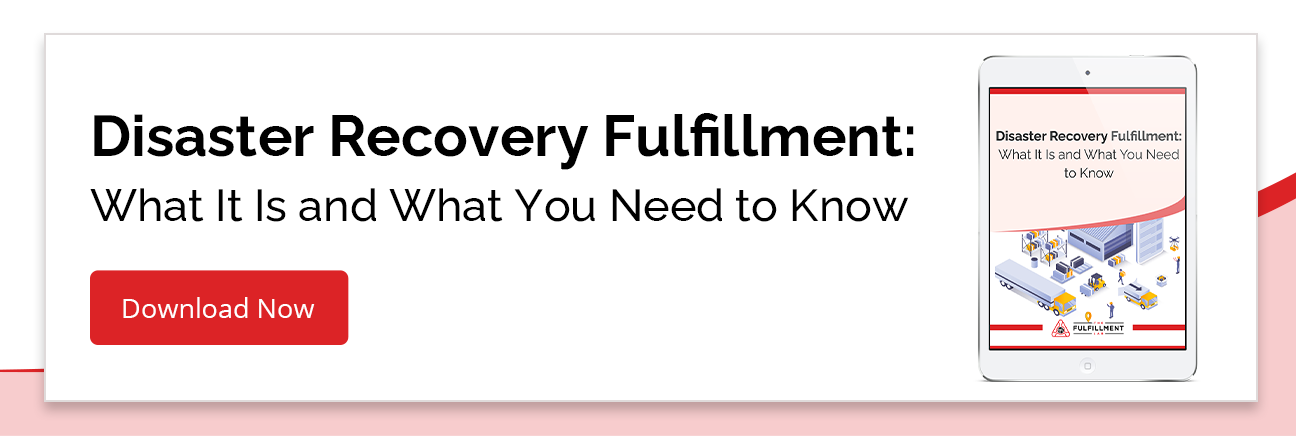Importance Of Disaster Recovery For Ecommerce Fulfillment
Pandemics, cybercrimes, outages, human error – and, of course, Mother Nature herself. Disaster can strike at any time, and it's not a matter of if one will happen, but when. So, it's best to always be prepared. How can eCommerce companies ready themselves for the inevitable? Let's take a look at disasters by the numbers, and then dive into how to create a disaster recovery fulfillment plan. You can also download our Disaster Recovery Fulfillment guide to share with your team.
What Is Disaster Recovery & Fulfillment Disaster Recovery?
In IT circles, there’s a concept called “disaster recovery,” in which a business tries to restore normal operations after some catastrophic failure in their technology or network. It involves a set of policies and procedures that need to be followed to enable the recovery or continuation of vital technology infrastructure and systems following a natural or man-made disaster.
Disaster recovery fulfillment is like that, but with a logistics-focused twist. Disaster recovery fulfillment can play a key role in ensuring business continuity—allowing the company to keep fulfilling customer orders after a disruption in their supply chain or shipping process. This could be accomplished by utilizing multiple fulfillment centers, moving to the cloud where data can be accessed from anywhere at any time, and so on. With a strong fulfillment disaster recovery plan, eCommerce business can save time and money, help retain customers, gain peace of mind, and perhaps even save the business following a devastating event.
Why Your Business Needs A Backup Order Fulfillment Plan
It's tempting to think, "it'll never happen to me," and forgo a disaster recovery plan. However, history shows us time and time again that disasters are an all-too-common reality. Just look at some of the events that impacted fulfillment in the past year alone:
COVID-19. Although the virus gave eCommerce businesses a shot in the arm as people began ordering goods online due to the lockdown, many eCommerce businesses were unprepared.
- According to data cited by Supply Chain Dive, 41% of businesses surveyed “Felt unprepared for shifting store locations into fulfillment hubs” in response to the COVID-19 outbreak. This led to an overwhelming number of backorders and stockouts.
- Unpreparedness led to delays in service to customers—and dissatisfied customers that were less likely to make future purchases or recommend the business’ services to others.
Cybercrimes. Data breaches have been growing in intensity and frequency over the years, and in 2020 they were up significantly as cybercriminals took advantage of the pandemic.
- Online retailers experienced more than twice as many account takeover (ATO) attempts than any other industry this year, with 62% of login pages being targeted.
- Ecommerce accounted for over 90% of the 64 billion credential stuffing, the automated injection of breached username/password pairs in order to fraudulently gain access to user accounts).
- Distributed Denial-of-Service (DDoS) attacks, in which cybercriminals disrupt the normal traffic of a targeted server by overwhelming it with phony traffic, increased with an average of eight application layer attacks per month against online retail sites.
Outages. When the power goes off, production comes to a grinding halt and can cost eCommerce businesses money and customers.
- Utility customers experienced 1.33 billion outage hours in 2020 according to PowerOutage.US, an aggregator of utility blackout data.
- The IT systems of nearly 25% of small businesses have gone offline in the past year.
- Small businesses say outage downtime creates business disruption and decreases employee productivity. 37% stated they had lost customers due to the outages and 17% have lost revenue due to downtime.
Human Error. Whether it’s forwarding an email to the wrong person, entering the wrong order number, or shipping the wrong product, human errors happen but even simple mistakes can have big consequences.
- The average cost of data breaches from human error stands at $3.33 million, according to IBM’s Cost of a Data Breach Report 2020.
- 62% of survey respondents say human error from manual process management is the #1 root cause of inventory fulfillment issues.
- 67% percent of respondents indicated being out of stock after an order was placed or simply overselling was the #1 inventory mistake that lead to lost customers with having the wrong product packed and delivered (17%) coming in second place.
Weather Events. 2020 was a record year for many reasons, and not in a good way.
- Hurricanes. In 2020, there were so many hurricanes in the Atlantic that the official alphabetical list of hurricane names was used up, only the second time in history this has occurred.
- Wildfires. Fires burned more than four million acres across California, the latest in California's history. Colorado also had its worst wildfire on record, with more than 208,000 acres burning across the state.
- Flooding. Heavy rains caused dam failures, resulting in the evacuation of 10,000 residents near Midland, Michigan.
- Tornadoes. There were 1,075 tornadoes in 2020, costing the economy an estimated three billion dollars. Some businesses were wiped out as twisters pummeled them with winds in excess of 250 miles per hour.
Having a backup order fulfillment solution to act as a kind of disaster recovery for fulfillment can be crucial for minimizing disruptions and keeping customers happy. This makes having access to a secondary distribution center crucial for minimizing the impacts of disasters on your eCommerce business.

The Five Critical Components Of An Ecommerce Business Continuity Plan
When setting up disaster recovery for eCommerce, you need a fulfillment solution to ensure business continuity. There are five key components that should be included in the plan:
1. A Business Impact Analysis (BIA)
How would disruptions to different parts of your supply chain or shipment processes affect your eCommerce business? What resources would you need to ensure operational resilience? A business impact analysis helps you answer these questions so you can prepare a better disaster recovery plan that covers your bases without wasting capital.
2. Multiple Distribution Centers
Physical fulfillment is hard to defend against if you have only a single warehouse and it’s destroyed or shut down. If your primary distribution center closes up, even just temporarily, do you have a backup location you can use to fulfill orders in the meantime? Planning for multiple distribution centers helps improve your eCommerce business’s resiliency in the event of a disaster.
3. Customer Communication Strategies
If there’s a disaster that affects your ability to fulfill orders, how will you communicate that to customers? Keeping customers in the know about major delays caused by floods, hurricanes, road damage, etc. can help manage expectations and improve customer satisfaction. After all, a customer is more likely to react positively to a delay if they know what caused it and what you’re doing about it.
4. Critical Inventory Identification
What are the items in your inventory that are most frequently ordered by customers? What items are more likely to sell during a major disaster? Identifying the critical inventory that your customers are most likely to order is a must for keeping them well-supplied and happy (while minimizing costs by not doubling up on every inventory SKU at a second site).
5. New Distribution Route Planning
How will products get to your customers from the new distribution site? What’s the best way to get around disaster-affected shipping areas to deliver products at an affordable cost? It’s important to consider new distribution routes and channels in your disaster recovery fulfillment plan to control costs and meet customer needs.
Simplify Fulfillment Disaster Recovery With The Fulfillment Lab!
According to FEMA, approximately half of all small businesses will never reopen following a disaster. That means if there’s no plan in place, it’s time to create one. Of course, setting up a comprehensive business continuity and disaster recovery plan for fulfillment can be tough and expensive. This is where eCommerce businesses can benefit from partnering with an experienced third-party logistics company like The Fulfillment Lab!
At The Fulfillment Lab, our disaster recovery team will tackle your small business disaster recovery fulfillment needs with ease using one of our 14 shipping facilities around the world. Our experience in dealing with carrier services and logistics challenges lets us tackle your biggest fulfillment issues—all so you can sit back, relax, and enjoy the benefits of fast and reliable fulfillment.
Are you ready to revolutionize your order fulfillment and take the stress out of planning for a disaster? Reach out to The Fulfillment Lab today and don't forget to download our new guide below!



